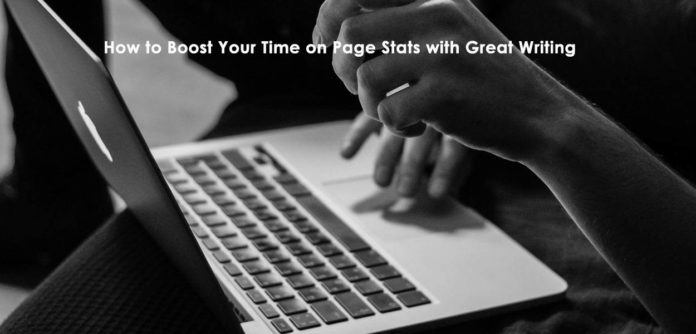Boost Your Time on Page Stats with Great Writing
Anyone who starts writing on the web eventually runs into the same problem: balancing writing what and how you want with what your readers want. In fact, this is an issue most writers must deal with at some point in their careers.
However, when you’re writing on the web for more than just fun, either as a part-time, work from home gig, or if you’re doing it to promote a personal project, it’s important you produce content that works well with search engines. That’s right: SEO.
Overall, a lot goes into good SEO writing. You need to target the right keywords and manage density. You need to choose strategic subheadings, and you also need to make sure your content is useful and relevant, as this will help you attract links and boost rankings.
But another ranking factor is “time on page,” which refers to the average number of seconds/minutes visitors to your site spend on the page.
Why Does Time on Page Matter?
Google and other search engines are designed to help users find what they are looking for as quickly as possible. As a result, their search algorithms are looking for clues that indicate when content published on the web succeeds at answering a person’s query.
One of these is time on page. The idea is that if someone spends time reading what you wrote, it’s because you managed to convince them you have the information they sought. In theory, the longer someone stays on your page, the better. Although, as is usually the case in SEO, there are exceptions.
As a writer, all of this means you need to get inside the minds of your readers and write content that convinces them to read your entire article, no small feat when dealing with people reading on their phones or computers.
How to Increase Time on Page
Here are some ideas about how to boost your time on page statistics:
Write a Killer Headline
You’ve probably heard this one a million times, but it’s so important we just had to say it again. This is because you won’t possibly be able to get someone to read your article if you don’t first convince them to click on it.
However, a good headlines goes beyond creating clickbait. You need to try and give your readers an idea of what they are going to get by clicking and reading.
This is important because it puts them in a good mindset before they start reading. If they click and are skeptical they are in the right place because the headline isn’t clear, they are much more likely to jump off the page before getting beyond the first few paragraphs.
Hook People with the Intro
When writing for the web, the goal of your first sentence is to get people to read the second. The purpose of the second is to convince them to read the third. And so on, and so forth.
Attention spans on the internet are short, so you have little time to get people’s attention.
Good ways to start include offering an interesting fact or posing a question. This often gets people intrigued and convinces them to read on. But don’t stop there. You need to keep bringing the good stuff all the way through the introduction.
Your introduction is the only way to convince people to read the rest of your article. When you write it and edit it, think: if I stumbled upon this, would I honestly keep reading?
Also, don’t start articles with “You’ve probably heard this a hundred times,” or “We are all more than aware.” If this is the case, then why do we need to read?!
It’s much better to go for shock and awe as this will hook people and get them to keep going, boosting those times on page stats and making everyone happy.
Deliver the “So What?” First
If your goal is hooking people, then you absolutely must include in your introductions the “so what?” This is the “what’s in it for me” part of the piece that is going to convince people that what you’re saying has real value and can make their lives better or easier.
When we first consider this, it might make sense to wait to deliver this until the end, much like a suspense film waits to deliver the twist until the final minutes. BUT THIS DOESN’T WORK WHEN WRITING FOR THE WEB.
Readers will get bored after a few paragraphs or sections and then they will simply click off the page and you’ll have lost them forever.
Of course, you can’t possibly deliver all the article’s relevant information in the first few paragraphs, but you can make it clear what people can expect to receive by giving you their valuable time to read your article.
Longer Articles, Subheadings, and a Table of Contents
Ideally, longer articles are better. They have been found to rank better on Google, partly because it takes people longer to read them, which means better “time on page” stats.
However, this rule is not black and white. Only write long form articles when it makes sense to do so. Remember, good content is always the priority.
But, if you can, try to target topics where you can flesh things out in more detail. When you do this, though, make sure to break up the article with subheadings. Someone might click on your article for one thing, and if you make them dig through mountains of text to find what they want, they probably won’t stick around.
Adding a table of contents after the introduction is another great idea. This allows interested readers to skip right to the content that is most relevant to them. Of course, this means they might not read the whole article, but this is much better than having them abandon your site because they had to scroll down too much (Yes, we have become this lazy).
Conclusion
Whether you already have a job writing for a company or organization, or if you’re looking to make it as a freelance writer, being able to write content people actually want to sit down and read is going to make you invaluable. But to get to this point, you need to practice. Find your voice, hone your craft, and learn what works. However, the tips we’ve outlined above are a great place to start.



















